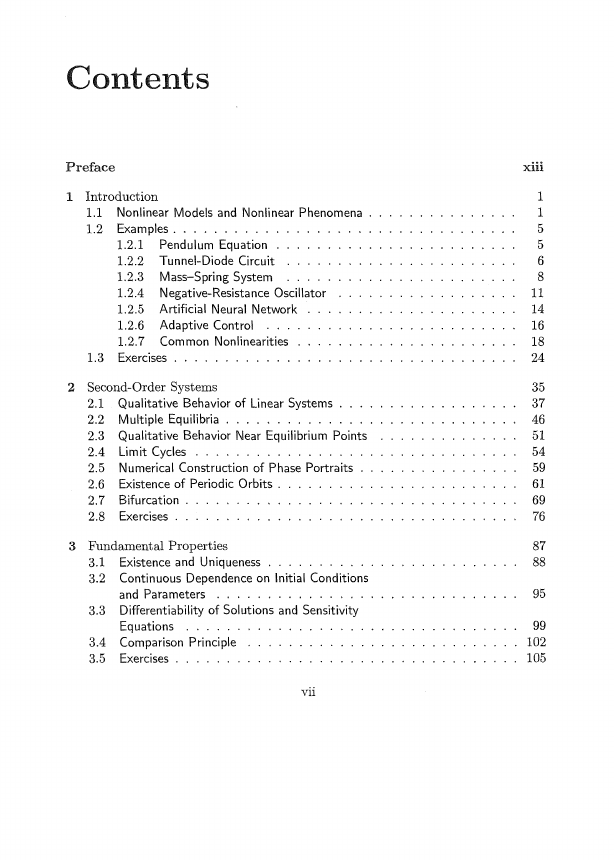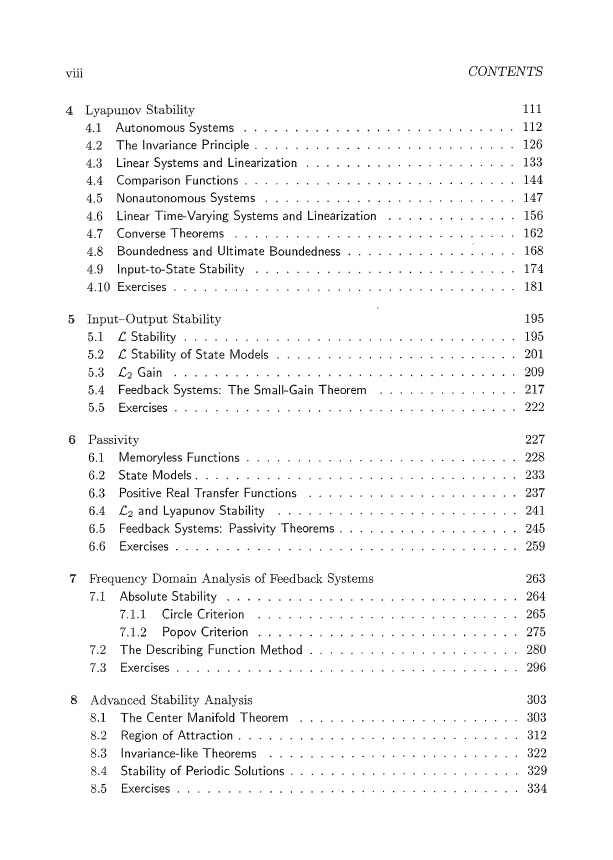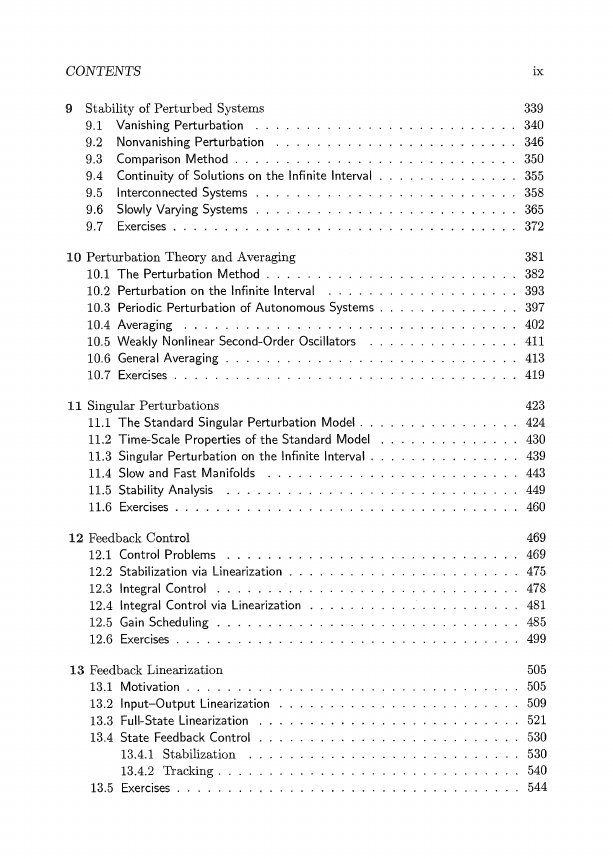�
Nonlinear SysteIlls
Third Edition
HASSAN K. KHALIL
Department of Electrical and Computer Engineering
Michigan State University
"~
j
Pl1~D!1Ji~e
Hall
~"
PRENTICE HALL
Upper Saddle River, New Jersey 07458
Library of Congress Cataloging-in-Publication Data
elP data on file.
Vice President and Editorial Director, ECS: Marcia Horton
Associate Editor: Alice Dworkin
Vice President and Director of Production and Manufacturing, ESM: David W. Riccardi
Executive Managing Editor: Vince O'Brien
Managing Editor: David A. George
Production Editor: Tamar Savir
Composition: PreTEX, Inc.
Director of Creative Services: Paul Belfanti
Creative Director: Carole Anson
Art Director: Jayne Conte
Art Editor: Greg Dulles
Cover Designer: Bruce K enselaar
Manufacturing Manager: Trudy Pisciotti
Manufacturing Buyer: Lisa McDowell
Marketing Manager: Holly Stark
© 2002, 1996 by Prentice Hall
Prentice-Hall, Inc.
Upper Saddle River, NJ 07458
All rights reserved. No part of this book may be reproduced in any form or by any means,
without permission in writing from the publisher.
The author and publisher of this book have used their best efforts in preparing this book. These
efforts include the development, research, and testing of the theories and programs to determine
their effectiveness. The author and publisher make no warranty of any kind, expressed or
implied, with regard to these programs or the documentation contained in this book. The author
and publisher shall not be liable in any event for incidental or consequential damages in
connection with, or arising out of, the furnishing, performance, or use of these programs.
Printed in the United States of America
10 9 8 7 6 5 4
ISBN 0-13-067389-7
Pearson Education Ltd., London
Pearson Education Australia Pty. Ltd., Sydney
Pearson Education Singapore, Pte. Ltd.
Pearson Education North Asia Ltd., Hong Kong
Pearson Education Canada, Inc., TOTOnto
Pearson Educaclon de Mexico, S.A. de C.V.
Pearson Education-Japan, Tokyo
Pearson Education Malaysia, Pte. Ltd.
Pearson Education, Upper Saddle River, New Jersey
�
To my mentor,
Petar V. K okotovic
A min a, Mohammad, Omar, Yousuf, and Suzanne
and my family
�
�
Contents
Preface
1
Introduction
1.1 Nonlinear Models and Nonlinear Phenomena
1.2 Examples . . . . . . . . . . .
1.2.1 Pendulum Equation .
1.2.2 Tunnel-Diode Circuit
1.2.3 Mass-Spring System
1.2.4 Negative-Resistance Oscillator
1.2.5 Artificial Neural Network
1.2.6 Adaptive Control ...
1.2.7 Common Nonlinearities
1.3 Exercises . . . . .
2 Second-Order Systems
2.1 Qualitative Behavior of Linear Systems
2.2 Multiple Equilibria . . . . . . . . . . .
2.3 Qualitative Behavior Near Equilibrium Points
2.4 Limit Cycles . . . . . . . . . . . . . . . .
2.5 Numerical Construction of Phase Portraits
2.6 Existence of Periodic Orbits.
2.7 Bifurcation
2.8 Exercises.... ..
3 Fundamental Properties
3.1 Existence and Uniqueness . . . . . . . . . . .
3.2 Continuous Dependence on Initial Conditions
and Parameters . . . . . . . . . . . . . . .
3.3 Differentiability of Solutions and Sensitivity
Equations ., ....
3.4 Comparison Principle
3.5 Exercises.......
vii
xiii
1
1
5
5
6
8
11
14
16
18
24
35
37
46
51
54
59
61
69
76
87
88
95
99
102
105
�
viii
4 Lyapunov Stability
4.1 Autonomous Systems
4.2 The Invariance Principle . . . . .
4.3 Linear Systems and Linearization
4.4 Comparison Functions . . . . . .
4.5 Nonautonomous Systems . . . .
4.6 Linear Time-Varying Systems and Linearization
4.7 Converse Theorems
. . . . . . . . . . .
4.8 Boundedness and Ultimate Boundedness
4.9
4.10 Exercises . . . . . .
Input-to-State Stability
5
.c Stability . . . . .
Input-Output Stability
5.1
5.2 £ Stability of State Models
5.3 £2 Gain . . . . . . . . . .
5.4 Feedback Systems: The Small-Gain Theorem
5.5 Exercises
6 Passivity
6.1 Memoryless Functions . . . . . .
6.2 State Models. . . . . . . . . . .
6.3 Positive Real Transfer Functions
6.4 £2 and Lyapunov Stability . , .
6.5 Feedback Systems: Passivity Theorems.
6.6 Exercises.................
7 Frequency Domain Analysis of Feedback Systems
7.1 Absolute Stability . . .
7.1.1 Circle Criterion . . . . .
7.1.2 Popov Criterion . . . . .
7.2 The Describing Function Method
7.3 Exercises . . . . . . . . .
8 Advanced Stability Analysis
8.1 The Center Manifold Theorem
8.2 Region of Attraction . . . . . .
8.3
Invariance-like Theorems .. ,
8.4 Stability of Periodic Solutions.
8.5 Exercises............
CONTENTS
111
112
126
133
144
147
156
162
168
174
181
195
195
201
209
217
222
227
228
233
237
241
245
259
263
264
265
275
280
296
303
303
312
322
329
334
�
CONTENTS
9 Stability of Perturbed Systems
9.1 Vanishing Perturbation .,
9.2 Nonvanishing Perturbation
9.3 Comparison Method . . . .
9.4 Continuity of Solutions on the Infinite Interval
9.5
Interconnected Systems
9.6 Slowly Varying Systems
9.7 Exercises . . . . . . . .
10 Perturbation Theory and Averaging
10.1 The Perturbation Method . . . . . . . . . . . .
10.2 Perturbation on the Infinite Interval . . . . . .
10.3 Periodic Perturbation of Autonomous Systems.
10.4 Averaging
. . . . . . . . . . . . . . . . . .
10.5 Weakly Nonlinear Second-Order Oscillators
10.6 General Averaging
10.7 Exercises . . . . .
11 Singular Perturbations
11.1 The Standard Singular Perturbation Model.
11.2 Time-Scale Properties of the Standard Model
11.3 Singular Perturbation on the Infinite Interval .
11.4 Slow and Fast Manifolds
11.5 Stability Analysis
11.6 Exercises ...
12 Feedback Control
12.1 Control Problems
12.2 Stabilization via Linearization
12.3 Integral Control
. . . . . . .
12.4 Integral Control via Linearization
12.5 Gain Scheduling
12.6 Exercises . . . . . .
13 Feedback Linearization
13.1 Motivation . . . . .
13.2 Input-Output Linearization
13.3 Full-State Linearization
13.4 State Feedback Control
13.4.1 Stabilization
13.4.2 Tracking.
13.5 Exercises . . . . . . .
ix
339
340
346
350
355
358
365
372
381
382
393
397
402
411
413
419
423
424
430
439
443
449
460
469
469
475
478
481
485
499
505
505
509
521
530
530
540
544
�
















 2023年江西萍乡中考道德与法治真题及答案.doc
2023年江西萍乡中考道德与法治真题及答案.doc 2012年重庆南川中考生物真题及答案.doc
2012年重庆南川中考生物真题及答案.doc 2013年江西师范大学地理学综合及文艺理论基础考研真题.doc
2013年江西师范大学地理学综合及文艺理论基础考研真题.doc 2020年四川甘孜小升初语文真题及答案I卷.doc
2020年四川甘孜小升初语文真题及答案I卷.doc 2020年注册岩土工程师专业基础考试真题及答案.doc
2020年注册岩土工程师专业基础考试真题及答案.doc 2023-2024学年福建省厦门市九年级上学期数学月考试题及答案.doc
2023-2024学年福建省厦门市九年级上学期数学月考试题及答案.doc 2021-2022学年辽宁省沈阳市大东区九年级上学期语文期末试题及答案.doc
2021-2022学年辽宁省沈阳市大东区九年级上学期语文期末试题及答案.doc 2022-2023学年北京东城区初三第一学期物理期末试卷及答案.doc
2022-2023学年北京东城区初三第一学期物理期末试卷及答案.doc 2018上半年江西教师资格初中地理学科知识与教学能力真题及答案.doc
2018上半年江西教师资格初中地理学科知识与教学能力真题及答案.doc 2012年河北国家公务员申论考试真题及答案-省级.doc
2012年河北国家公务员申论考试真题及答案-省级.doc 2020-2021学年江苏省扬州市江都区邵樊片九年级上学期数学第一次质量检测试题及答案.doc
2020-2021学年江苏省扬州市江都区邵樊片九年级上学期数学第一次质量检测试题及答案.doc 2022下半年黑龙江教师资格证中学综合素质真题及答案.doc
2022下半年黑龙江教师资格证中学综合素质真题及答案.doc